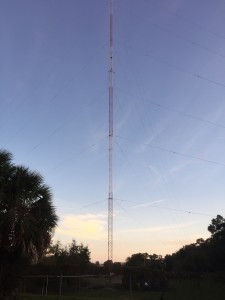
City Attorney Lysia Bowling misled the Pensacola City Council with a rather narrow legal opinion on the Ground Lease between the City of Pensacola and Divine Word Communications that she rendered an hour before the council’s Nov. 12 meeting.
Further, her opinion set a precedent for future redevelopment inside of the city of Pensacola that makes the elimination non-conforming uses and structures nearly impossible.
Bowling cited the Section 12-1-16 of the Land Development Code to argue that the non-conforming use of Divine Word’s radio tower was a lawful non-conforming use and structure because its use had continued uninterrupted since the original tower was built in 1974. Read CA_Tower.
Failure to look at Florida Statutes & Comprehensive Plan
However, the city attorney failed to take into account Chapter 163 of the Florida Statutes and the City of Pensacola’s Comprehensive Plan, according to a legal opinion rendered by attorney John Asmar.
Asmar served as Mayor Ashton Hayward’s chief of staff from March 2009-February 2013. Because the radio was considered an operational issue, he was not involved in advising the mayor on the radio tower issue, the negotiations with Divine Word, drafting of the lease, or its presentation to the city council. City Administrator Bill Reynolds took full responsibility for the lease when he presented it in May 2012. Reynolds signed the executed agreement on the behalf of the mayor.
According to the 11-page opinion, the Florida Statutes, the City’s Comprehensive Plan and its Land Development Code “specifically prohibited the replacement/restoration, extension, expansion and enlargement” the original radio tower built in the Long Hollow stormwater basin and the extension, expansion and enlargement of the tower’s use.
As per the Land Development Code, the original tower was a non-conforming use and non-conforming structure. The tower was specifically prohibited in the Conservation District but was allowed to continue to exist under certain conditions.
Chapter 163 of Florida Statutes requires the elimination of non-conforming structures and uses that are inconsistent with the character of the community. The City’s Comprehensive Plan prohibits existing non-conforming uses that are inconsistent or incompatible with the plan to be expanded, enlarged and/or rebuilt. The City’s Land Development Code declares non-conforming structures may be maintained, but not enlarged in a way that increases its non-conformity.
According to the opinion, the removal of the original 250-ft tower and the construction of a newer, larger, 350-400 ft. tower in a slightly different location constituted a replacement/restoration, extension, expansion and enlargement of the non-conforming structure and extension, expansion and enlargement of the non-conforming use.
“Further, Chapter 163 of Florida Statutes requires that all development approved by the City be consistent with the City’s (Comprehensive) Plan and the City’s LDC (Land Development Code),” wrote Asmar. “In the instant case, the City’s action(s) was/were not consistent with the City’s Plan and the City’s LDC, and thus, was/were not permitted and/or authorized by Florida law.”
Bixler v. Pierson
In his legal analysis, Asmar cited Bixler v. Pierson, 188 So.2d 681 (Fla App. 4th Dist., 1966), in which the Court granted a mandatory injunction ordering a removal a new trailer on grounds the placement of the new trailer was in violation of zoning regulations.
The Defendant-Appellee, before the enactment of zoning regulations, maintained an old house trailer upon his property. The zoning prohibited the use or presence of trailers. The Defendant-Appellee’s trailer was permitted to remain under the non-conforming use provision found in the zoning ordinance.
The zoning ordinance enacted at the time prohibited non-conforming buildings, structures and uses of land from being extended or enlarged. The Defendant-Appellee, with the permission of the zoning director, replaced the old trailer with a new and larger trailer on his property.
The Court held that the trailer was a structure, and the removal of the old trailer and the placement of the new trailer constituted an alteration, extension and enlargement of a non-conforming structure that was prohibited by the zoning regulations. Further, the Court stated that the substitution permitted the perpetuation of the non-conforming structure contrary to the clear intent of the zoning regulations construed as a whole and the purpose of the zoning regulations governing the same were to eliminate non-conforming structures over time.
The Bixler ruling has been cited in several land use cases since 1966 and has been upheld repeatedly.
What the ruling means for Pensacola
Like Bixler, the removal of the original 250-ft tower and the replacement with a newer, larger, 350- to 400-ft tower constituted the replacement/restoration, extension, expansion and enlargement of a non-conforming structure. Unlike Bixler, the extension, expansion and enlargement of the non-conforming tower structure also extended, expanded and enlarged the tower’s non-conforming use. All of which were in violation of the City’s Plan and the City’s LDC.
Further, like the Court’s holding in Bixler, the replacement/restoration permitted the perpetuation of the non-conforming structure and the extension, expansion and enlargement of a non-conforming use was contrary to the clear and stated intent of the regulations contained in Chapter 163 of Florida Statutes, the City’s Plan and the City’s LDC.
Asmar warned that if the city attorney’s opinion is allowed to go unchallenged then non-conforming uses and structures would be allowed to exist in perpetuity, unless abandoned for more than 12 months.
“If left uncorrected, the City’s action(s) could set a legal precedent for future proposals for the redevelopment of non-conforming structures and non-conforming uses,” wrote. “Like the holding in Bixler, the new, extended, expanded and enlarged Long Hollow drainage basin commercial communication tower should be removed from the site.”
Read Long Hollow Opinion.



